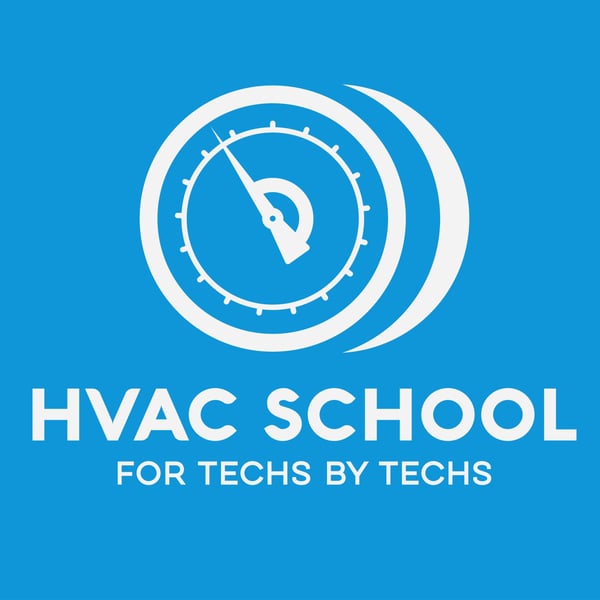Water Source - The Water Side w/ Eric Mele
HVAC School - For Techs, By Techs
Bryan Orr
4.8 • 985 Ratings
🗓️ 2 August 2018
⏱️ 45 minutes
🧾️ Download transcript
Summary
In this episode, Eric Mele dives into the world of pumps, controls, cooling towers, and everything else related to the water side of a water source heating and cooling system. Many of these systems are water-to-water setups that use heat exchanges for heat transfer. You can listen to an introduction to water source heat pumps HERE.
A cooling tower is where we reject the heat that we put into water loops. Most of these towers are of the induced-draft variety, meaning that they have fans drawing/blowing air through them. Some cooling towers are "wet" towers, where water is open to the fluid you're working with, so some of that water is lost to evaporation. Contamination can be an issue with the wet open-type towers, but strainers, chemicals, and proper planning (for location) can prevent contamination. Dry towers do not need constant refilling and need fewer precautions against contamination.
These water-to-water systems use centrifugal pumps to push water through the system. These circulate water molecules, NOT compress them. Water source heat pumps get their heat from boilers, not the outdoor air in most air source heat pumps. When you have gas boilers, you have to think about your typical furnace concerns, including combustion air and carbon monoxide.
Air can sometimes circulate with the water, and you'll want to minimize that as much as possible, such as via air bleeds. These air bleeds may have ball valves that you can use to purge a lot of air. Other systems may not have air bleeds, but you will still need to get air out of the system.
Eric and Bryan also discuss:
- Makeup water float assemblies
- Strainers and cleaning procedures
- Heat exchanger configurations
- Water sources and quality control
- Water treatment
- Couplings and alignment
- Boiler configuration
- Bypass valves
- Expansion tanks
- Water source heat pump controls
- Variable frequency drives
- Aquastats
Learn more about Refrigeration Technologies HERE.
Transcript
Click on a timestamp to play from that location
| 0:00.0 | and This episode of the HVAC School podcast is made possible by our cadre of sponsors. |
| 0:22.0 | I'm not really sure what a cadre is but I think it's like a group. |
| 0:24.1 | So our sponsors are Mitsubishi, heating and cooling, carrier at carrier.com, |
| 0:30.3 | air oasis at air oasis.comcom you can actually go to a form at |
| 0:35.0 | Air Oasis.com forward slash go and get more information on their full line of |
| 0:40.4 | products we've talked about the nano and the bipolar in previous |
| 0:44.4 | episodes. If you want to find out more go back and listen to those. I interviewed one of |
| 0:48.1 | the founders of Heroasis. But if you're at the stage where you want to find out |
| 0:51.3 | more about their products, maybe find out the pricing or you can get them locally, go to air oasis.com forward slash go. |
| 0:58.0 | Also want to thank refrigeration technologies. They make all kinds of chemicals that we use every day at Kailos. It falls in the category of a sponsor that I was kind of at my fingers crossed hoping I would get for a long time because I can speak glowingly about their products. Many of you have used Big Blue and |
| 1:13.7 | maybe Nylog but if you haven't tried their Viper Cleaners then I would suggest |
| 1:17.7 | you go out and give them a shot especially the aerosol can with the Viper Cleaner |
| 1:21.7 | in it. I was actually skeptical of that because I've used |
| 1:24.3 | aerosols before and it's sort of like why not just mix up your own but the nice thing about |
| 1:27.4 | the aerosol can and the vipers that it's a really fine pin spray so you can spray it |
| 1:32.3 | especially when you're doing like a |
| 1:33.4 | slant evapor coil trying to clean it in place or you're working on maybe a |
| 1:36.9 | reach in refrigeration unit where you're trying to clean some grease off of |
| 1:39.5 | a condenser. It's a really nice package for doing that and it's non-toxic as well, which is very nice. |
| 1:44.7 | That is refrigeration technologies. Find out more by going to RefriggeTech.com. |
| 1:49.1 | And then finally I have to mention UEEI, the UEEI Hub 6. Hub 4 and Hub 2 smart kits. Good kits of smart probes. I've already talked a lot about them. |
| 1:57.7 | Also a podcast about that in the past that you can listen to if you want to find out more |
... |
Please login to see the full transcript.
Disclaimer: The podcast and artwork embedded on this page are from Bryan Orr, and are the property of its owner and not affiliated with or endorsed by Tapesearch.
Generated transcripts are the property of Bryan Orr and are distributed freely under the Fair Use doctrine. Transcripts generated by Tapesearch are not guaranteed to be accurate.
Copyright © Tapesearch 2025.

